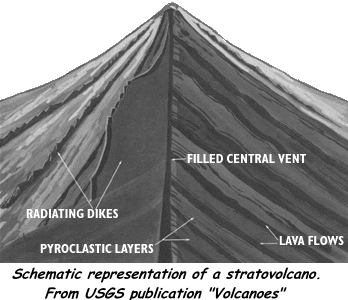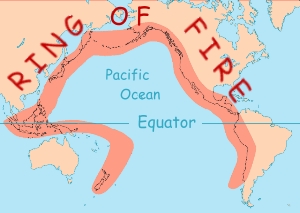Teachers Guide to Stratovolcanoes of the World
Introduction
What is a volcano?
A volcano
is simply a hole or vent in Earth's
crust through which molten rock,
steam and other gases come forth. Scientists group volcanoes into four
main kinds--cinder cones,
strato- or composite volcanoes,
shield volcanoes, and lava
domes. Volcanoes take their name from the island of Vulcano in
the Mediterranean Sea. Long ago people thought this island mountain was
the chimney of the blacksmith forge of the Roman God Vulcan. The steam
and ash that came out of the vent was a sign that Vulcan was working at
his forge making weapons for Jupiter and Mars. In Hawaii and other Polynesian
islands, local people once attributed volcanic eruptions
to the Goddess Pele. They believed Pele was moving from island to island
as she sought to escape her evil sister, Na Maka O Kaha'i, the goddess
of the sea. Today scientists understand that volcanic eruptions are surface
reminders of Earth's still hot interior.

![]() Return to Top
Return to Top
Where do volcanoes
occur?
Volcanic eruptions do not occur
just anywhere. Sixty percent of all active volcanoes are found at crustal
plate boundaries such as the Pacific Plate, which has become known as
the Ring of Fire because of the
active volcanoes on its perimeter. Earth's crust, like the cracked shell
of a hard-boiled egg, is broken into a number of "plates."
These floating pieces of the crust are moving about very slowly on the
hotter interior. Where the plates are moving apart or colliding with one
another, volcanoes may form. Many volcanoes form oceanic islands in the
Pacific Ocean or Mediterranean Sea. These volcanoes formed over "hot
spots" in the crust and mantle. The Northern Hemisphere has approximately
two thirds of the land-based volcanoes.
![]() Return to Top
Return to Top
Are all volcanoes dangerous?
Not all volcanoes erupt
and not all eruptions are explosive. Volcanologists label volcanoes active,
dormant, and extinct,
depending on the likelihood of an eruption occurring. Volcanoes that will
never erupt again are considered extinct. . Active volcanoes come in two
classes -- volcanoes which are active, either erupting now or having recently
erupted and dormant volcanoes, volcanoes which are currently quiet but
are expected to erupt in the future. About sixty volcanoes are actively
erupting each year.
Not all volcanoes erupt explosively.
The style of eruption (quiet lava flows versus violent explosions of gases,
ash, and debris) and frequency of eruption are related to the viscosity
and amount of dissolved gas in
the magma. Hot, runny magmas
with little dissolved gas tend to flow smoothly out of vents and produce
broad gentle volcanoes. The shield volcanoes of Hawaii are examples of
this type of eruption. While such flows are not especially dangerous to
humans, they can destroy buildings and agricultural land.
Somewhat cooler magma with more dissolved gas is more viscous. The magma
does not run smoothly, but rather oozes out like toothpaste, clogging
the vent. As the magma rises closer to Earth's surface, the pressure decreases
and gases dissolved in magma separate from the liquid. If the gases cannot
escape, pressure builds. When the pressure from the trapped gases exceeds
the pressure of the overlying rock, an eruption occurs. This is typically
a sudden violent blast sending
particles as far as 20 miles high and many miles away from the volcano.
The erupted material can range in size from tiny particles of ash
to house-size boulders. Commonly there is little, if any, lava
extruded. Such eruptions can be very dangerous and even deadly. It is
difficult to predict when a long dormant volcano will become active. Because
they erupt infrequently, unpredictably, and violently, and because they
occur in populated areas, these explosive volcanoes pose the greatest
danger to humans.
![]() Return to Top
Return to Top
What are Stratovolcanoes?
Stratovolcanoes,
also called composite volcanoes, are typically steep-sided, symmetrical
cones built of alternating layers of lava flows, volcanic ash, and other
eruptive products (see animation
courtesy of Exploring the Environment).
Most stratovolcanoes have a crater
at the summit containing a central
vent or a clustered group of vents. Lavas either flow through breaks in
the crater wall or issue from fissures
on the flanks of the cone. Lava, solidified within the fissures, forms
dikes that act as ribs which greatly strengthen the cone. Their stable
construction allows stratovolcanoes to rise as much as 2,400 meters above
their bases. The essential feature of a composite volcano is a conduit
system through which magma from a reservoir
deep in Earth's crust rises to the surface. The volcano is built up by
the accumulation of material erupted through the conduit and increases
in size as lava, cinders, ash, etc., are added to its slopes. These volcanoes
are most often found at crustal plate
boundaries. In this Guide, we will focus on eight stratovolcanoes
featured on the Stratovolcanoes of the World poster available
from NCEI. These volcanoes are located in the Pacific Ring of Fire.

